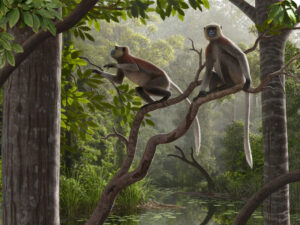March 2023
Conversation Window – A Chat with Nina Jablonski by Club SciWri
Nina Jablonski is a scientist, educator, author, and a strong advocate for racial equity. She is the Evan Pugh Professor of Anthropology at Pennsylvania State University and is dedicated to uncovering the evolution of human skin and skin pigmentation.
“The science of skin has been a very rewarding topic and one in which there is inexhaustible interest,” Jablonski said on ‘Reason with Science’, where she takes us on a journey of human evolution, the loss of our body hair and the gain of skin pigmentation, and how science can be used to dismantle racism.
December 2022
Jablonski to present at the Commemorative Symposium for the 37th International Prize for Biology
Nina Jablonski will present her lecture, titled Understanding the Evolution of Human Diversity and Adaptations in Light of Our Primate Ancestry, on December 15, 2022 at the University of Tokyo. The event will celebrate the awarding of the International Prize for Biology to Dr. Timothy Douglas White, Professor of Integrative Biology and Director of Human Evolution Research Center, University of California at Berkeley, USA. This year’s Prize is awarded in the field of the Biology of Human Evolution.
Jablonski to present at the Sage Center for the Study of the Mind
Nina Jablonski will present her talk Skin Stories: The Evolution and Meanings of Humanity’s Most Important Interface at UC Santa Barbara’s Sage Center on January 19, 2023. She will discuss the evolution of “functionally naked” skin and skin pigmentation, and the diverse consequences of these innovations for human lifestyles and lives through time. The evolution of skin pigmentation emerges as a complex story of adaptation influenced by natural selection, population bottlenecks, and myriad cultural practices. Naked skin becomes a biosocial interface of consummate importance because its visual impact lends itself to decoration and to being a basis for judgment of innate human value based on appearance.
September 2022
Nina Jablonski writes for The Conversation – Human skin stood up better to the sun before there were sunscreens and parasols – an anthropologist explains why
Human beings have a conflicted relationship with the sun. People love sunshine, but then get hot. Sweat gets in your eyes. Then there are all the protective rituals: the sunscreen, the hats, the sunglasses. If you stay out too long or haven’t taken sufficient precautions, your skin lets us you know with an angry sunburn. First the heat, then the pain, then the remorse.
Were people always this obsessed with what the sun would do to their bodies? As a biological anthropologist who has studied primates’ adaptations to the environment, I can tell you the short answer is “no,” and they didn’t need to be. For eons, skin stood up to the sun.
May 2022
Jablonski to give HOT (Human Origins Today) Topic presentation
 Nina Jablonski will present “The Evolution of Skin Tones: A Reflection of Human Adaptation and Health” in a virtual lecture for the Smithsonian National Museum of Natural History’s HOT Topic series. Moderated by Briana Pobiner, the virtual event will take place on Thursday May 19, 2022 from 11:30AM – 12:30PM EDT.
Nina Jablonski will present “The Evolution of Skin Tones: A Reflection of Human Adaptation and Health” in a virtual lecture for the Smithsonian National Museum of Natural History’s HOT Topic series. Moderated by Briana Pobiner, the virtual event will take place on Thursday May 19, 2022 from 11:30AM – 12:30PM EDT.
August 2021

July 2021
From The Conversation – The story of an African children’s book that explains the science of skin colour
Skin We Are In is a landmark South African book for children (and grown-ups) on the subject of skin colour. Published in 2018, it was co-authored by an artist and a scientist, both South African luminaries – the author Sindiwe Magona and the anthropologist and palaeobiologist Nina Jablonski. Here they talk about how – and why – the book came about.
Nina Jablonski writes for The Conversation – Racism has a physical impact on the body – here’s how
“But race thinking has deformed us and society because it’s based on constructs of otherness and difference. These, in turn, underpin expectations of character, intelligence, motivation and behaviour. They can pave the way for the unleashing of suspicion, derogation and dehumanisation.
Racism affects health and often leads to early death. We now know in greater and more disturbing detail how this occurs. It kills directly and abruptly when people are murdered by police or vigilantes, but it also kills through disease. COVID-19 is new, but diseases common to the survival zones of the urban poor have been with us for a long time. It was only a century ago that the bone disease rickets was so common among African American children of eastern US cities that it was considered a rite of passage.”
October 2020
Fossils Of 6.4 Million-Year-Old Monkeys Are Among The Oldest Found Outside Of Africa

“The story of how monkeys conquered the world is a remarkable tale that includes an improbable trip across the Atlantic on a floating island that broke away from mainland Africa. In yet another twist, researchers have just uncovered the remains of an ancient species that lived in what is now China some 6.4 million years ago, suggesting that monkeys had reached the Far East at a time when ancient apes still roamed Asia.”
Oldest Monkey Fossils Outside of Africa Found
Three fossils found in a lignite mine in southeastern Yunnan Province, China, are about 6.4 million years old, indicate monkeys existed in Asia at the same time as apes, and are probably the ancestors of some of the modern monkeys in the area, according to an international team of researchers.
“This is significant because they are some of the very oldest fossils of monkeys outside of Africa,” said Nina G. Jablonski, Evan Pugh University Professor of Anthropology, Penn State. “It is close to or actually the ancestor of many of the living monkeys of East Asia. One of the interesting things from the perspective of paleontology is that this monkey occurs at the same place and same time as ancient apes in Asia.”